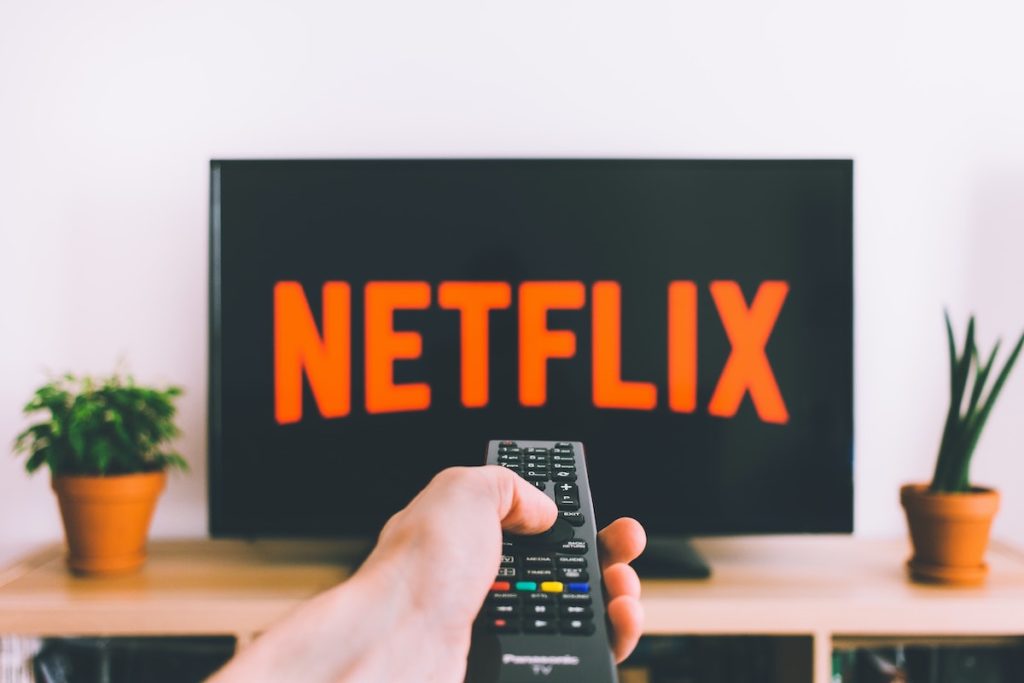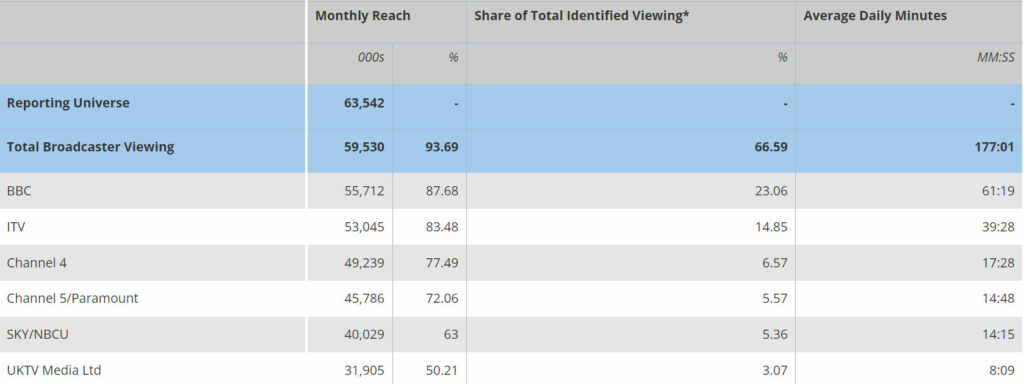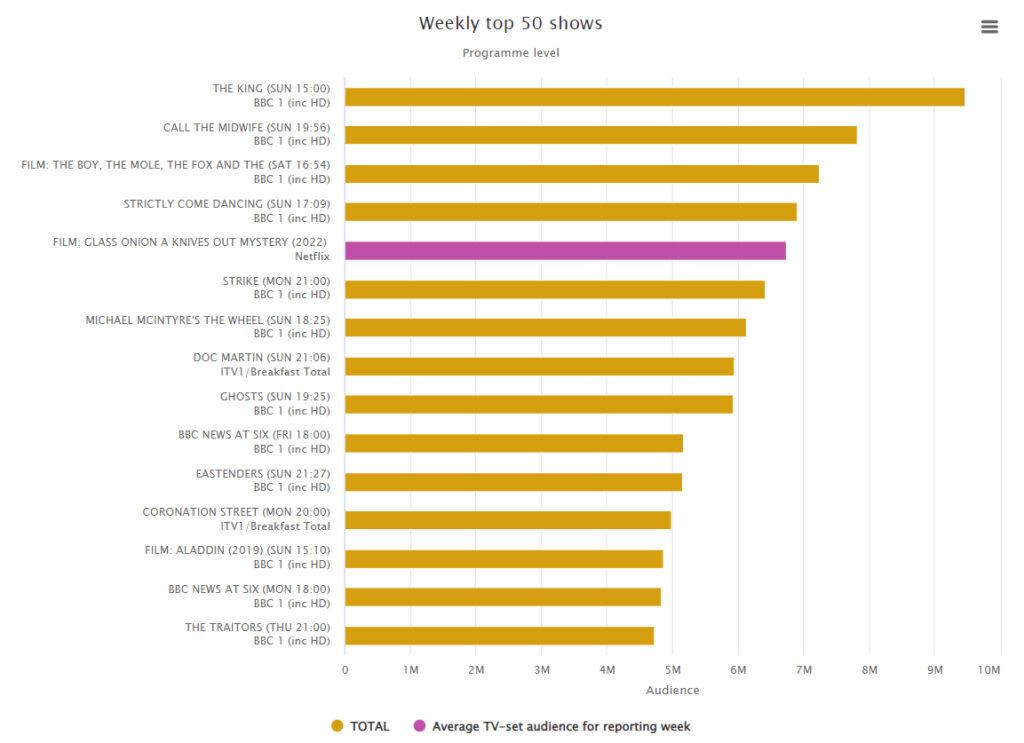At the end of last year, UK TV measurement body BARB began reporting viewing figures for Netflix, lifting the lid on the traditionally cagey streaming giant as it introduces advertising for the first time. After the first couple of months of Netflix numbers being reported, here’s what we’ve learnt.
Netflix trails BBC and ITV on viewing, but narrowly beats Channel 4
In December 2022, Netflix took a 9.19 percent share of BARB’s total identified viewing. It sits comfortably on top of the streaming pile, above Disney+ (3.39 percent) and Amazon Prime Video (3.27 percent), bringing the combined total of SVOD and AVOD consumption above 16 percent of the total viewing share.
But the UK broadcasters still make up two-thirds of total viewing, led by the BBC (23.06 percent) and ITV (14.85 percent). Channel 4 falls just below Netflix on 6.57 percent, with Channel 5 (5.57 percent), Sky (5.36 percent) and UKTV (3.07 percent) dropping behind the SVOD service.
Netflix shows rarely enter the top 50
BARB also reports the most-watched shows every week, and Netflix is generally conspicuous by its absence. In December the top 50 was dominated by BBC 1 and ITV1, with Strictly Come Dancing and the World Cup scoring particularly highly over the Christmas period.
However, Netflix titles have entered the top 50 on three occasions. The first episode of Wednesday placed 48th in the first week of December; the following week saw three episodes of Harry & Meghan enter the fray. The streaming service found its highest ranking when Glass Onion: A Knives Out Mystery became the fifth most-watched title of Christmas week, the only non-BBC entry in the top five.
Netflix drove an overall increase in December viewing
Total viewing in December rose to an average 266 minutes per day, climbing from 253 minutes in November. According to BARB, “this was mostly accounted for by a month-on-month increase in total SVOD/AVOD daily viewing minutes from 36 to 43 minutes.” This increase was mainly driven by Netflix with 24 minutes average daily viewing, up from 20 minutes in November.
Behind the numbers
It is worth noting that BARB’s figures for SVOD programmes only track the first seven days of their availability, and only include TV set viewing, a methodology that risks under-reporting Netflix viewing.
“Netflix and its competitors’ services were born to be viewed on smaller screens, and after a time of adoption by all age groups, viewing has moved to the big screen,” notes Hannah Walsh, Research Manager at Ampere Analysis. “This will largely be skewed by age. Ampere’s consumer survey shows that smartphone viewing accounts for 29 percent of daily viewing time for the age group 18-24 compared to 20 percent on Smart TV. If you include tablet and computer viewing, this increases to 61 percent of daily viewing time.”
Also noteworthy is that December would expect an increase in viewing over the Christmas period, especially the kind of communal TV watching that tends to be served by live events – and this year had the unusual addition of the World Cup, which proved a significant draw for both ITV and the BBC. Just last week Digital UK, the consortium that runs Freeview and Freesat, changed its name to Everyone TV, reflecting its principal of “We TV” compared to the more streaming-oriented “Me TV”.
“There is still a very important space for traditional TV in the living room, particularly for live shows and news,” says Walsh. “Live shows encompass a few different types of titles – live sporting events (both weekly and one-off tournaments such as the World Cup), live Awards events but also live reality shows such as I’m a Celebrity or Strictly Come Dancing. These shows can gather large audiences across all demographics of a household who want to keep up to date with live eliminations instead of risking seeing spoilers online. But for shows such as Wednesday or Harry & Megan, while there may be discussion around these shows, it is easier for a consumer to view in their own time.”
Coming soon
But Netflix has its own plans for live events, beginning with a Chris Rock special this year, and the SAG Awards streamed annually on the service starting in 2024 – potentially paving the way for live sports, following in the footsteps of Amazon and Apple TV+.
“If this test is successful, we may see Netflix stream future live events across genres,” comments Walsh. “It will be interesting to see if the platform purchases any sports rights after the success of Formula 1: Drive to Survive, and in addition, its competitors including Amazon, Peacock and Paramount+ are beginning to snap up sports rights.”
This would certainly strengthen the streamer’s proposition for advertisers, who are largely still waiting for Netflix to offer the reach provided by the incumbent broadcasters.
“Although the latest figures show Netflix is competing with the likes of Channel 4 for overall share of viewing, when we look at the breakdown for individual programmes, Netflix still have very little programming that competes with the broadcasters for reach,” says Liz Duff, Head of Commercial & Operations at UK independent agency Total Media. “Although Netflix programmes are the leaders of the streaming world, only their very highest-performing programmes can compete with the best of broadcast TV.”
“The area that is increasingly interesting for advertisers is time spent by channel,” she adds. “In December, Netflix delivered an average of 24 minutes viewing per day, only being outperformed by BBC 1 and ITV, demonstrating a great level of stickability. It’s this high level of engagement that makes Netflix appealing to advertisers as a platform, although it’ll be interesting to see if the introduction of advertising will impact this longer-term.”








